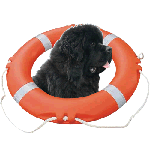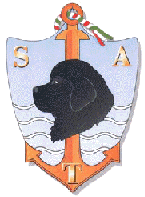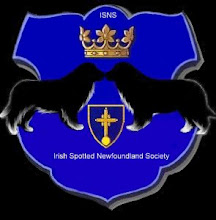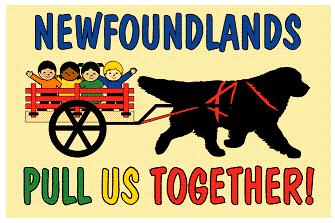Monday, February 28, 2011
Monday, February 21, 2011
Satchie, BOW, Santa Clara Valley Kennel Club
Thursday, February 17, 2011
The GGNRA's DEIS Reflects A Conflict Between A "National Park" And "A National Recreation Area"

(Courtesy of Dr. Suzanne Valente)
First and foremost, the GGNRA is, both in name and legislatively, a recreational area. Unfortunately, its management wishes otherwise. It is not governed by traditional notions of conservation but rather by its recreation first mandate.
"This conflict has become one of legislative intent: the GGNRA/NPS desire to manage this Golden Gate National Recreation Area as a National Park, while the enabling legislation and the will of the people assert the management should reflect the unique requirement we have for recreational access in the GGNRA.
This is a long-standing battle we have waged; the GGNRA takes away recreational access, and the citizens turn to the courts to have access reinstated. It has been a colossal waste of time and money, and a hardship for the citizens because not only are we battling for our right to access; we are also paying for both sides of the debate.
Although the current dispute is in regards to off-leash recreation, there have been many disputes with GGNRA/NPS management reflecting this conflict between access for recreation versus the GGNRA’s desire to create an urban, behind-the-ropes national park; a "look but don't touch" area. Current GGNRA Superintendent Frank Dean was quoted in the NPS Traveler as saying about the DEIS; “This is truly a defining moment for Golden Gate National Recreation Area”. Dog guardians have proven to be the greatest obstacle to the GGNRA's desire to remove recreation from their name and the effective management of this Recreation Area. Should the GGNRA succeed in removing the right of access for dog guardians, the other recreational interests will not have a chance.
What follows is a partial list of the groups/interests who have had substantive disputes with GGNRA management: Sea Scouts, Stinson Homeowners Association, equestrians, Surfrider Foundation, hang gliding enthusiasts, SF SPCA, Peninsula Humane Society, SF and Marin Firefighters, Presidio Historical Association, In Defense of Animals, California Farm Bureau, Mycological Society of SF, Presidio Fire Department, Marin Humane, Animal Care and Control of SF, The Community of West Marin, Men’s Circle and Burners without Borders. Disability Rights Advocates is again in litigation (after a failed mediation) against the GGNRA for their failure to provide access to the disabled in most areas of the GGNRA. The City of Sausalito litigated against the GGNRA, as did bicyclists. The debacle at Drakes Bay Oyster Farm in which Dianne Feinstein intervened to resolve by legislation should also be mentioned as it exemplifies the shoddy (or most aptly "devious") “science” the NPS relies upon when it suits them. The goes on and on.
The GGNRA was established in part through a campaign in 1970 by Secretary of Interior Walter Hickel "to bring parks to the people", putting the National Park Service in a movement to increase outdoor recreation in urban areas. (U.S. Department of Interior News Release, September 14, 1970.) Congress established the GGNRA on October 27, 1972 "to preserve for public use and enjoyment certain areas of Marin and San Francisco Counties, California possessing outstanding natural, historic, scenic, and recreational values.” (16 U.S.C. Sec. 460bb.)
In addition to this generic statement of purpose appearing in most national park statutes, Congress included two "specific provisions" unique to the GGNRA. First, the park was established "to provide for the maintenance of needed recreational open space necessary to urban environment and planning." Second, the GGNRA enabling statute imposes a unique limitation on NPS's discretionary power for "management of the recreation area" by providing that the "Secretary of Interior ... shall utilize the resources in a manner which will provide for recreation and educational opportunities consistent with sound principles of land use planning and management."
When voting for Charter Section 7.403-1(a) authorizing the transfer of nearly 60% of the City parklands, the citizens of San Francisco were told that "the transfer of these lands is a technical resolution allowing the City and County of San Francisco to transfer city lands to the Golden Gate National Recreation area, a national urban park established in 1972 by Congress to preserve 34,000 acres of land and water in San Francisco and Marin for recreational use by all citizens." Aware that certain unique restrictions were included in the enabling statute requiring the NPS to maintain "recreational open space necessary for urban environment and planning", San Francisco adopted the "technical resolution" authorizing the transfer of City parks for "recreational use by all citizens." Allaying concern over the transfer of the property, the NPS promised the City that "historical recreational use" would be continued. The GGNRA has now expanded to include almost 80,500 acres, including lands in San Mateo County.
The 1979 Pet Policy was established as the official off-leash recreation policy for the GGNRA as required by the enabling statute and the promise made to the City. NPS issued press releases of the official off-leash policy (Lynn Thompson memo to Coalition For San Francisco Neighborhoods, 10/17/78). Again, NPS told San Francisco this policy was developed because the "[e]xisting federal regulations' were not "a viable situation in an urban area". At the time this policy was created, off-leash access was limited to less than 1% of the acreage in the GGNRA. In contrast, today’s GGNRA has more than doubled in size, while the acreage available to off-leash recreation has been systematically reduced.
In 1989 the GGNRA, under the supervision of Brian O’Neill, signed on to a biosphere habitat program entitled “Man and Biosphere Habitat Programme” (“MAB” or “MAP”). One would be hard pressed to find a philosophy in greater conflict with the recreational priority of the GGNRA than that of Peter Bridgewater, Secretary of the MAB/MAP Programme, who has said, “Earth would be a better place if we had no people.” The GGNRA’s Chief of Natural Resources Management and Science, Daphne Hatch, has embraced this philosophy. She was quoted in the San Francisco Chronicle on September 7, 2005 as saying "Ocean Beach without the people is an incredible habitat. But people think of it as a sandbox or their backyard." Ms. Hatch has conducted the studies the GGNRA relied upon to close the majority of Ocean Beach to off-leash recreation. Ocean Beach (if you include the beach south of Sloat to Fort Funston) is 3.6 miles long. In this DEIS, the GGNRA proposes to ban dogs from 2.9 miles of this beach to include a .25 mile purported habitat for the Western snowy plover and a 2.65 mile “buffer zone”. The purported habitat is not critical habitat; no plovers nest or breed here. Two studies done here in the GGNRA have shown that 99.67% of the dogs observed do not chase plovers and that plovers are not disturbed in their feeding by off-leash dogs or people. These studies are not mentioned or relied upon in this DEIS, and the ban of dogs is a draconian measure imposed without consideration of potential mitigations. Further, the tides are so high and the erosion so great in this area of the beach that the GGNRA is forced to bulldoze the “habitat” each year when the plovers leave to breed elsewhere, and a portion of the adjacent highway has been subject to seasonal closures due to collapse. This is just one example of how it has become the pattern and practice of the GGNRA, in a broad scope, to create or declare areas as habitat adjacent to historic off-leash recreational areas, then utilize the proximal existence of “habitat” to justify the elimination of off-leash recreation and sometimes human access as well. It is not relevant to the GGNRA whether the “habitat” under consideration supports threatened or endangered species - all face maximum recreational restrictions. When a listed species is present, the GGNRA perverts ESA regulations so as to treat each area as if it is “critical habitat” (even if not classified as such by USFWS). Restrictions are imposed without consideration of mitigations or the analysis of the negative impact of the loss of access as opposed to the potential success of protection which is required by the ESA.
In 2001, the GGNRA reneged upon their 1979 Pet Policy and unilaterally eliminated off-leash recreation in the GGNRA entirely; citing that off-leash recreation was in violation of NPS Regulations. This action resulted in public outcry and the S.F. Board of Supervisors threatened reversion of certain properties. In 2005, United States District Court judge WIlliam Alsup noted in his decision affirming the legality of the 1979 Pet Policy in the GGNRA, his findings regarding the history of pet management in the GGNRA:
“In sum, for more than twenty years, the GGNRA officially designated at least seven sites for off-leash use. This was not accidental. It was a carefully articulated, often studied, promulgation. The responsible GGNRA officials in 1978 and thereafter presumably believed they were acting lawfully. Even now, the government concedes that the GGNRA had full authority at all times to relax the general leash rule at the GGNRA but argues it could have done so, at least after 1983, only via a “special regulation.” In other words, the agency allegedly used the “wrong” procedure back in 1978 (and thereafter) even though a “right” procedure to reach the desired result was available and could have been used. The government has not revealed its internal justification for following the “wrong” process. Whatever it was, the justification was abandoned in 2002 with the two-word explanation that it had been “in error.” With this ipse dixit, the NPS wiped away two decades of policy, practice, promulgations, and promises to the public.” (United States v. Barley, Order Of Affirmance, supra, p. 5; published decision at http:/www.ggnranews.blogspot.com.)
Despite the fact that GGNRA management had been given permission to create a Section Seven Special Regulation for off-leash recreation in the GGNRA; when the Court reinstated the 1979 Pet Policy, the Superintendent refused to make the 1979 Pet Policy a Section Seven Special Regulation. He instead instituted a Negotiated Rulemaking process that was unlawful and did not reach consensus. Subsequently, the initiation of the DEIS was announced. The explanation for this might be found in a quote from then Western Regional Director (now NPS Director) Jon Jarvis. At the NPS Centennial Initiative Listening Session (Presidio Officer's Club, San Francisco, March 22, 2007) Director Jarvis said to me and my husband, and I quote, "I would rather give up those [the GGNRA] properties than have dogs running loose on them." [This is not unlike the statement from Brian O'Neill that "I will not have dogs running loose in my park."]
In 2008, the GGNRA supported an attempt by Nancy Pelosi to surreptitiously slip a Park name change (and therefore a change in the governing mandates) from National Recreation Area to National Park through bill H.R. 6305. This action can be construed as an admission that the NPS/GGNRA is aware their actions do not conform to the enabling legislation. Public outcry upon the discovery of this section in HR 6305 forced Nancy Pelosi to withdraw her blatant attempt to circumvent the will of the people and the Federal Court.
Now in 2011, we are presented with this 2,400 page DEIS. The Federal Register states: “This plan will promote the following objectives: preserve and protect natural and cultural resources and natural processes, provide a variety of visitor experiences, improve visitor and employee safety, reduce user conflicts, and maintain GGNRA resources and values for future generations.” There is no mention of recreation or its value in this Recreation Area. With the addition of a “Compliance-based Management Strategy” the GGNRA has cleared the way to incrementally eliminate the few areas they recommend for off-leash recreation in the preferred alternative.
The enabling legislation requires the GGNRA to utilize sound principles of land use planning and management. Accepted practice would be illustrated by the Rattlesnake National Recreation Area and Wilderness (RNRAW) which produces an annual monitoring report. The report assesses current recreation trends, needs, and impacts, and thereby serves as a tool for long-term management of the RNRAW. When the GGNRA announced the DEIS in the Federal register, I filed a Freedom of Information Act Request (dated April 11, 2006) to provide the data, documents, and/or Staff Report which substantiated their claim of controversy over the dog policy, compromised visitor and employee safety and resource degradation which warranted this current DEIS. The GGNRA’s response merely stated: “The Staff Report and other documents you seek do not exist at this time”. An appeal to the Department of the Interior regarding this FOIA request elicited the following response after several letters: “Since the Department has not made a determination on your appeal within the time limits set in the FOIA, you may seek judicial review under 5 U.S.C. 552(a)(4)(B). However, we hope that you will delay filing the lawsuit so that the Department can thoroughly review the issues in your appeal and make a determination. We appreciate your patience to this point and the Department will make every effort to reach a decision on your appeal as soon as possible.” This letter is dated August 8, 2006. There has been no written response as of yet.
I am advised by legal counsel the lack of data to support the assertions used as justification to proceed with this Environmental Review would violate the enabling legislation; and also make this agency action arbitrary, capricious and an abuse of discretion. It is presumed this agency action, findings and conclusions should be set aside as prescribed by the Administrative Procedure Act, 5 U.S.C. 706 (2)A. Further, when data regarding the actual citations/incidents was finally released to other parties through the Negotiated Rulemaking, we find that there are 37,709,444 dog visits per year (in the time frame of 2001-2006), and there was an "incident" reported for every 1,362,992 dog visits. (please note that an "incident" is any dog related event that is reported and is not neccessarily a dog bite).
It would seem there was no data available because the actual data did not support their decision to conduct the DEIS in the first place. There is also the matter of the Memorandum of Understanding between the City of SF and the GGNRA. It would not seem that the GGNRA has allowed the City the ability to oversee management decisions as was originally intended when the properties were turned over for inclusion into the GGNRA."
It is incumbent upon the City to continue to insist that the Park be used for its primary purpose - recreation. Otherwise, the City has a trust obligation to take back its former lands from the despotic rule of the GGNRA.
Monday, February 14, 2011
The Plover "Science" in the GGNRA's DEIS is Fundamentally Flawed

This is an addendum to the Ocean Beach DOG comment previously submitted to the GGNRA with respect to the 2008 closure of a section of Ocean Beach referred to as the “Plover Protection Area”. This addendum is intended to supplement the previous comment and respond to the new plover issues as outlined in the 2011 DEIS for the GGNRA.
As noted in the original comment, this 2011 DEIS again fails to mention a 2007 study by Meg Warren of U.C Berkeley which found that plover feeding is not negatively impacted by recreational activities of humans and dogs. This is critically important because the plover does not nest or breed at Ocean Beach or Crissy Field; its primary activity here is feeding and foraging for food. Instead of acknowledging the Warren study, this DEIS relies in large part upon a study by Matthew Zlatunich and Michale Lynes of the Golden Gate Audubon Society. This new study, like the Warren study, was conducted in cooperation with the GGNRA.
The new Zlatunich study was conducted in 2009/2010 at Crissy Field in San Francisco. The study exhibits many of the scientific shortcomings noted in OB DOG's original comment, most notably that the study is merely observational in nature.
The observational collection of data was performed by Audubon volunteers who had a bias — Audubon has publicly advocated the banning of dogs to protect the plover; yet their study made no attempt to ascertain comparative effects on the plover. There is no discussion of the disturbance level perpetrated by other sources, even though they tell us that data was collected.
Raw data is not provided to the reader.
The analysis is biased and untrustworthy because it is based upon incomplete data. For example, the level of disturbance is not categorized in the analysis even though we are told they were categorized in their collection.
Assumptions are made in the Audubon analysis without supporting explanation. For example, they decided to assign the disturbance to an on-leash dog if he was closer to the plover than his guardian. This ignores the possibility the disturbance was due to the number of bodies such as two people walking which coud disturb a plover to the same extent as a leashed dog and a person.
To clarify the issue of comparative disturbance, it seems odd that although known predators of the plover are acknowledged to be at Crissy Field, no attempt is made to analyze the disturbance they create for the plover. The Common Raven and American Crow are present, yet ignored in the analysis. Beyond this, the California Gull is noted as being present. This is of interest because a recent study using surveillance cameras at plover nesting sites in San Francisco Bay documented California Gulls as being responsible for 25% of all predation of plover nests. (Robinson-Nilsen, Caitlin1, Jill Bluso Demers1, Cheryl Strong2, and Scott Demers 3; 1 San Francisco Bay Bird Observatory, crobinson@sfbbo.org; 2 U. S. Fish and Wildlife Service, Don Edwards San Francisco Bay National Wildlife Refuge; 3 HT Harvey and Associates DETERMINING THE EFFECTS OF HABITAT ENHANCEMENTS AND PREDATORS FOR WESTERN SNOWY PLOVER). California Gulls are new to some of these areas. Thus, the decline in the number of plovers at Crissy Field could well be related to an increase in the presence of California Gulls. Yet the study makes no attempt to ascertain if there is any such correlation.
The authors in this study note the number of plovers has been steadily declining since 2005/2006 records. They choose to rely upon previous conclusions that the greatest disturbance impact to wildlife within the Wildlife Protection Area at Crissy Field is caused by dogs, joggers and walkers. The data from this study showed the number of dogs and humans in the plover area spiked in 2008/2009, and declined dramatically in 2009/2010. The number of plovers continued to decline, despite the reduction in recreational disturbance in 2009/2010. This could lead one to conclude that there is no correlation between the number of dogs and people and the number of plovers present. There is no discussion of this possibility in the data analysis of this study.
This study is without scientific merit because it deliberately misleads the reader about the GGNRA’s legal obligations to protect the plover. Ocean Beach and Crissy Field are not designated as critical habitat by the USFWS. Therefore, the GGNRA is obligated only to prevent the harassment or taking of the plover within its boundaries. Appendix B contains the legal definition of a disturbance which would constitute harassment and be a violation of the law: “If the observer witnesses a blatant violation of the law, such as a dog owner knowingly and without regard allowing his dog to harass wildlife, the observer shall make note on the comment sheet and shall, upon completion of the survey, file a wildlife harassment report at the park police station…” There is no indication in this study analysis that any observer ever witnessed this type of harassment of a plover during their observations.
Alternatively, this study records “disturbances” which they define as minor, moderate and major—none of which rise to the level of the legal and accepted definition of a disturbance that is utilized by USFWS and other studies. For example, the authors state: “a minor disturbance will cause a resting bird to stand”. A clear thinking individual can conclude that a minor “disturbance” as defined by this study is really no disturbance at all. Worse yet, when analyzing the number of “disturbances” observed, there is no acknowledgement as to how many of these “disturbances” are actually minor, moderate or major based upon these authors' criteria. It is entirely possible (and probable) that each of the disturbances recorded and utilized to justify the restriction of recreation were merely minor “disturbances”. This would be consistent with the conclusions of other studies which have found: “…snowy plovers in other areas have become habituated to relatively constant and non-threatening human trail use.” (Trulio, Lynne1 , Caitlin Robinson-Nilsen2, Jana Sokale3 and Kevin Lafferty4 1 San Jose State University; Lynne.Trulio@sjsu.edu ; 2San Francisco Bay Bird Observatory; 3 Sokale Environmental Planning; 4 Western Ecological Research Center, US Geological Survey NESTING SNOWY PLOVER RESPONSE TO NEW TRAIL USE.)
In summary, the GGNRA/Audubon study and its recommendations are flawed, dishonest and biased. The DEIS advocates recreational restrictions based upon this study. Clearly, the failure in this study to find any violation of the law with respect to the protection of the plover, and the omission of studies that contradict the need for recreational restrictions render this aspect of the DEIS invalid and discredit the conclusion that recreational restrictions must be implemented to protect the plover in the GGNRA.
Sunday, February 13, 2011
Thursday, February 10, 2011
The GGNRA DEIS Ignores Independent Studies Showing That Off-Leash Recreation Does Not Impact Plovers

In its Draft EIS, the GGNRA continues to ignore recent scientific atudies whose findings do not serve the purpose of eliminating off-leash recreation.
One example is a U.C. Berkeley Environmental Sciences study presented by Megan Warren on
May 7, 2007 which concludes that within the GGNRA, the feeding of the Western Snowy Plover does not appear to be negatively affected by human and pet recreation. This is highly significant. Because the Western Snowy Plover does not nest or breed at Ocean Beach or Crissy Field, its primary essential activity is foraging and feeding. If human and pet recreation does not negatively affect those activities, there is no need to restrict recreation in these areas.
The abstract states, in pertinent part:
Recreation Disturbance Does Not Change Feeding Behavior of the Western Snowy Plover
"The Western Snowy Plover (Charadrius alexandrinus nivosus) is a small shorebird that has many scattered wintering populations along the Pacific Coast of the United States, including several in the Bay Area.
"This species has been listed as threatened since 1993 under the federal Endangered Species Act of 1973. For this study I measured disturbance rates, types, plover responses and feeding time in three different sites in the San Francisco Bay Area to explore the link between recreation disturbance and feeding behavior. I predicted
that as frequency of disturbance increased, the birds would spend less time actively foraging and more time alert. However, data showed no significant relationship between feeding behavior and direct disturbance by human recreators. Instead, I now predict that recreation has a more indirect effect on the western snowy plover feeding behavior. Future research should focus on indirect effects of recreation, such as habitat disturbance and food source quality."
One must seriously question the efficacy of the DEIS in completely ignoring such studies and instead relying upon the findings of its own staff, which are not scientifically viable but are inherently biased.
Saturday, February 5, 2011
Environmental Impact in the GGNRA: People or Dogs

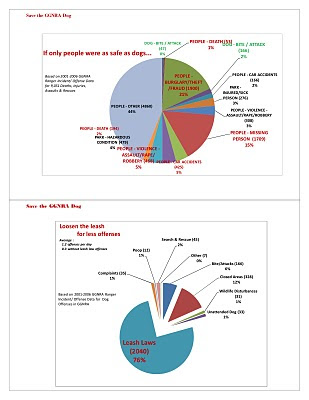

From five years of Incident Reports obtained from the Golden Gate National Recreation Area, the charts below demonstrate that the recreational (and other)activities of people have a far more destructive impact on the environment than do off-leash dogs, who are only allowed in less than 1% of the GGNRA per the 1979 Pet Policy.
So one has to ask, why did the GGNRA spend millions of taxpayer dollars to produce a 2,400 page Draft EIS in order to attempt to make its case against off-leash recreation, yet ignore the impact of people? The answer is clear: this is not science aimed at objectivity but rather aimed at a fait accompli to eliminate dogs from the GGNRA. Shame on them and those who continue to aid and abet their fraud on the public.
Tuesday, February 1, 2011
Subscribe to:
Posts (Atom)



